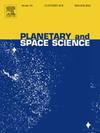Production of carbon samples with extreme physical conditions using intense heavy ion beams at the facility for antiprotons and ion research: Application to planetary physics research
IF 1.7
4区 物理与天体物理
Q3 ASTRONOMY & ASTROPHYSICS
引用次数: 0
Abstract
The possibility of existence of carbon-rich-planets makes it important to study High Energy States of carbon in order to understand the internal structure of such planets. In this paper, we present two-dimensional hydrodynamic simulations of a low-entropy compression of a carbon sample that is enclosed in a high-Z cylindrical shell that is driven by a high intensity uranium beam. The considered beam parameters are the ones that will be available at the accelerator facility, named, FAIR, at Darmstadt. This study has shown that the carbon sample can be compressed to 2 to 3 times solid density and ultra-high pressures are achieved. The temperature, on the other hand, remains relatively low. These are the typical physical conditions that are expected to exist in the planetary interiors. An experimental study of the thermophysical and transport properties of such samples will significantly improve our knowledge about formation and evolution of different type of planets.
在反质子和离子研究设施中使用强重离子束在极端物理条件下生产碳样品:在行星物理研究中的应用
富碳行星存在的可能性使得研究碳的高能态以了解这类行星的内部结构变得非常重要。在本文中,我们提出了低熵压缩碳样品的二维流体动力学模拟,该碳样品被封闭在高z圆柱壳中,由高强度铀束驱动。所考虑的光束参数将在达姆施塔特名为FAIR的加速器设施中使用。这项研究表明,碳样品可以被压缩到固体密度的2到3倍,并且可以实现超高压。另一方面,气温仍然相对较低。这些是预期存在于行星内部的典型物理条件。对这些样品的热物理和输运性质的实验研究将大大提高我们对不同类型行星形成和演化的认识。
本文章由计算机程序翻译,如有差异,请以英文原文为准。
求助全文
约1分钟内获得全文
求助全文
来源期刊

Planetary and Space Science
地学天文-天文与天体物理
CiteScore
5.40
自引率
4.20%
发文量
126
审稿时长
15 weeks
期刊介绍:
Planetary and Space Science publishes original articles as well as short communications (letters). Ground-based and space-borne instrumentation and laboratory simulation of solar system processes are included. The following fields of planetary and solar system research are covered:
• Celestial mechanics, including dynamical evolution of the solar system, gravitational captures and resonances, relativistic effects, tracking and dynamics
• Cosmochemistry and origin, including all aspects of the formation and initial physical and chemical evolution of the solar system
• Terrestrial planets and satellites, including the physics of the interiors, geology and morphology of the surfaces, tectonics, mineralogy and dating
• Outer planets and satellites, including formation and evolution, remote sensing at all wavelengths and in situ measurements
• Planetary atmospheres, including formation and evolution, circulation and meteorology, boundary layers, remote sensing and laboratory simulation
• Planetary magnetospheres and ionospheres, including origin of magnetic fields, magnetospheric plasma and radiation belts, and their interaction with the sun, the solar wind and satellites
• Small bodies, dust and rings, including asteroids, comets and zodiacal light and their interaction with the solar radiation and the solar wind
• Exobiology, including origin of life, detection of planetary ecosystems and pre-biological phenomena in the solar system and laboratory simulations
• Extrasolar systems, including the detection and/or the detectability of exoplanets and planetary systems, their formation and evolution, the physical and chemical properties of the exoplanets
• History of planetary and space research
 求助内容:
求助内容: 应助结果提醒方式:
应助结果提醒方式:


